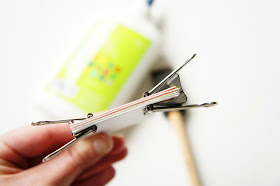Now the fun part! Or the tricky explaining part if you're me!
Grab one end of the sheet yarn and make a simple slip knot. This is going to be the centre of your rug.
Insert your hook into the loop.
Pick up the long end of the fabric and loop it once over your hook
And pull that loop through the first loop (the slip knot loop)
Pull it through to make a new loop.
I also made a video to help you see the process a little better:
Continue making a chain of loops until you have between 5-7 chains. I'm never really precise with this either and I probably should be. I usually just listen to what the fabric tells me since it tends to naturally want to curve into a circle on its own after a certain amount of loops.
This is kind of the tricky part. You have to find your original loop hole and, with your hook still in the last loop, stick it into the original loop
Loop the long end of fabric over the hook (just as you've been doing all along)
And pull that fabric through the original loop
Then keep pulling it through the loop your hook was already through (or the last loop in your chain) and close the circle.
Here it is in video form to help you see a bit better again:
Now you have to continue around the circle by finding a loop, pushing your hook through
pulling a new loop through that hole
and pulling it through the last loop
Another video helping you to see this a little clearer:
Continue around and around like so.
Some important things to note.
Try to keep the stitches (loops) tight but not too tight. If you make them too tight, the round will start to curve up on itself and you'll end up with a bowl (I've made my fair share of these!). If the stitches (loops) are too loose, then the rug will be too stretchy and you'll end up with gaps. This is something that takes a lot of practice to get perfect, so take your time figuring it out and don't feel discouraged if you have to take apart a whole rug and redo it. That's part of learning.
You'll have to add double stitches (loops) as you go along to help with keeping things comfortably loose (not too loose) and to help the rug lay flat. Double stitching basically means that instead of pulling one loop through a hole, you're going to pull two. So you'll pull your first loop through both loops (so many loops!) and then you'll pull another one through that same loop just as before.
Here's a video to help explain:
I usually don't have to make too many double stitches at the beginning, but as you get larger, you'll be using a lot more double stitches. The larger you go, the more space you'll need to take to make the rug lay flat. This just takes a lot of practice to know when, but generally, if my last loop doesn't match up with the next hole and I feel like I have to stretch it over to get into that spot, I'll make a second stitch (you don't want to pull it tight).
As I said before, if you mess up, don't be discouraged, just pull out the loops and start again. The great thing about this is that no matter how big you get, you can always pull out any mistakes you make and start over. I've had rugs almost finished and I find that all of a sudden, a round is getting a little tight and curving up. So I've pulled out the entire round and started again. It sucks but it's not the end of the world.
Practice this up and then next week, I'll show you how to switch fabrics!
























































